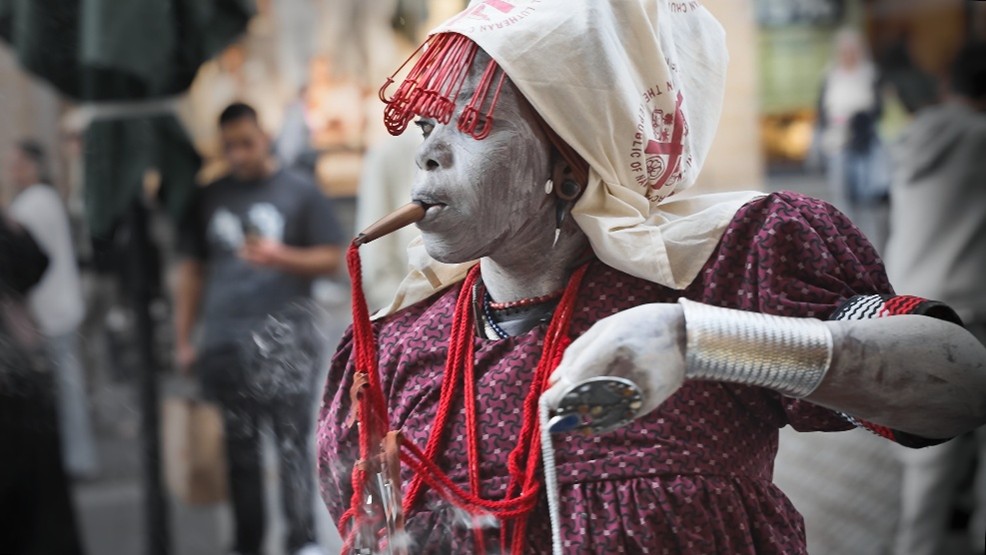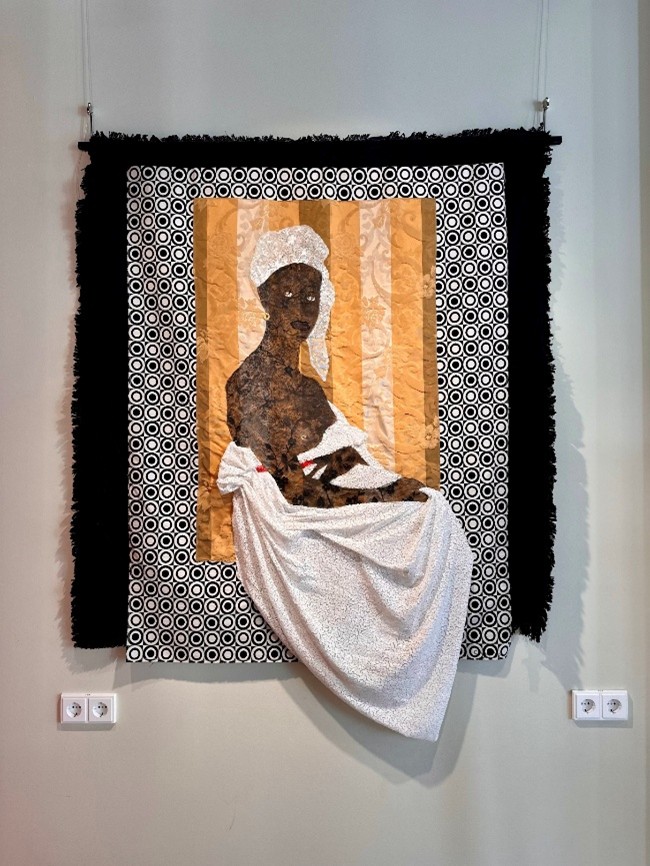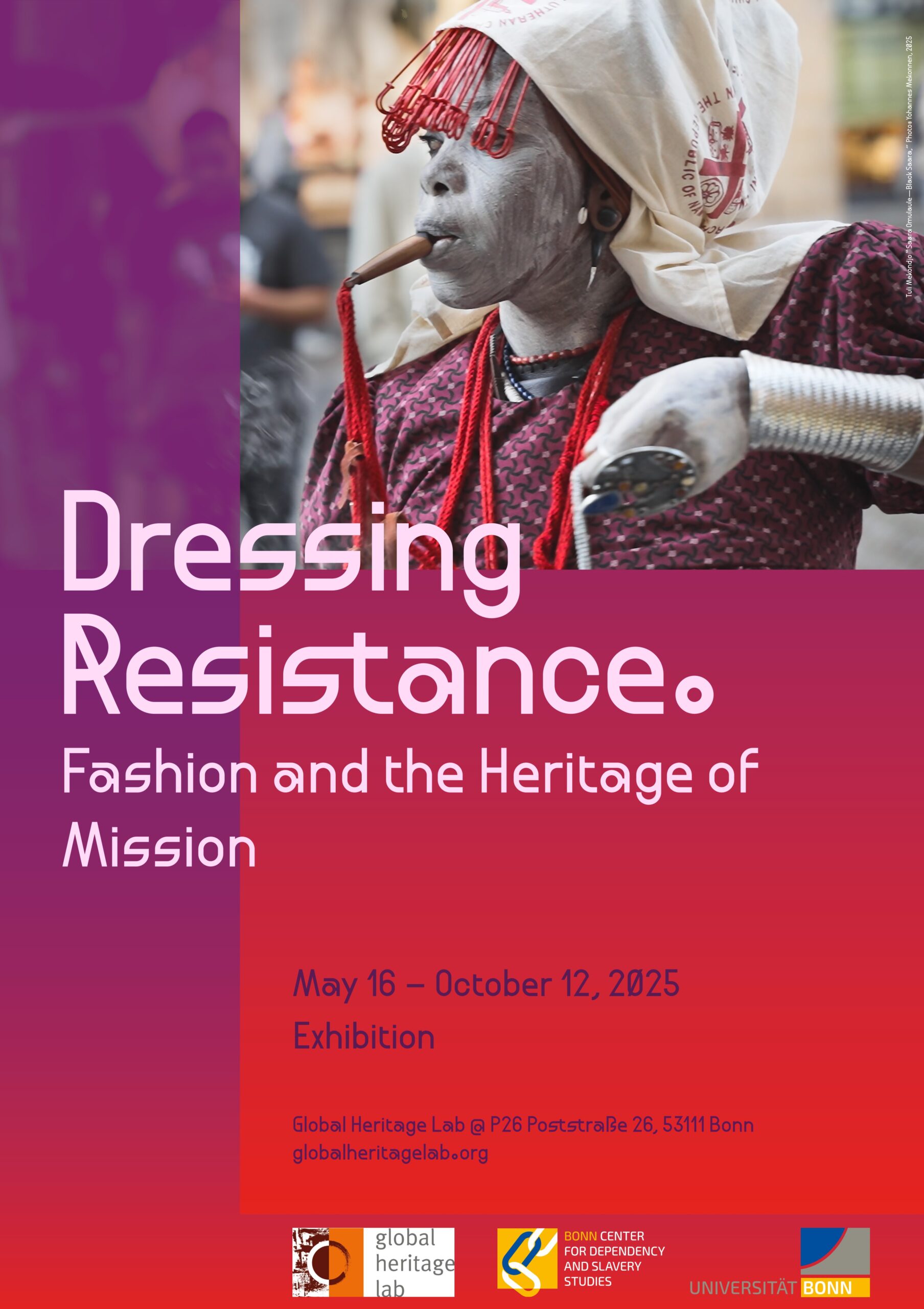
Dressing Resistance
Fashion and the
Heritage of Mission
15 May – 12 October 2025
Photo: Yohannes Mekonnen
 By Jun.-Prof. Dr. Julia Binter and
By Jun.-Prof. Dr. Julia Binter and  Yohannes Mulat Mekonnen
Yohannes Mulat Mekonnen
The exhibition Dressing Resistance: Fashion and the Heritage of Mission explores the question of how Christian missionisation has influenced fashion in Africa, Latin America, and the Caribbean and how fashion designers and artists deal with this legacy today. It builds on an international conference Interwoven Dependencies. Fashion and the Heritage of Mission with academics and cultural practitioners at the Global Heritage Lab and shows artworks by Tuli Mekondjo (Namibia), Cheryl McIntosh (Jamaica/Bonn), Amanda McIntyre (Trinidad and Tobago), Loo Nascimento (Brazil), and many more. The exhibition is hands-on. It invites visitors to weave on a 2×2 metre weaving frame by Peruvian-German artist Sofía Magdits Espinoza or learn how to make Namibian dolls. This brings topics like the body, fashion, and identity to life in a way that is engaging and accessible for both students and families.

Cheryl McIntosh, “Madeleine”, 2021. Photo: Courtesy of the artist.
Dressing Resistance is in dialogue with the exhibition Enmeshed and Entwined – Textures of Dependency by the Cluster of Excellence Bonn Center for Dependency and Slavery Studies (BCDSS) and the Bonn Centre for Digital Humanities (BCDH). Enmeshed and Entwined the social entanglements and asymmetrical dependency relationships inherent in one of our oldest cultural assets. At the centre of the exhibition is a large quilt that forms the ‘narrative’ framework for the multi-layered history of the ‘textures of dependence’ in a series of ‘story patches’ from different eras and regions. Using multimedia, visitors learn what textiles – from coarse fabrics to fine silks, from workwear to fashion – tell us about forms of dependency such as enslavement, serfdom, forced labour or contemporary factory work in the Global South. The stations show how textiles were interwoven with social, economic and political hierarchies across eras and regions and what dependencies characterise global trade routes and supply chains then and now.
The exhibitions will open on 15 May 2025 at 6 p.m. with a welcoming address by the Rector of the University of Excellence Bonn, Prof. Dr. Dr. h.c. Michael Hoch, and an artistic performance by Sofía Magdits Espinoza (Peru/Germany).
Opening hours of the exhibitions: 16 May 2025–12 October 2025, Wed-Sun, 2-6 pm, Global Heritage Lab in P26, Poststraße 26, 53111 Bonn
Veranstaltungen in Deutsch
Mittwoch, 4.06.2025, 16:00-17:00 Uhr: Kuratorinnen-Führung mit Dr. Beatrix Ihde-Hoffmann, Exhibition Curator, BCDSS
Sonntag, 6. Juli 2025, 14:00–18:00 Uhr: Wissenschaft trifft Kunst: Weben in Peru, Nos vemos en el cosmos, Cielo XIV
Im Gespräch: Prof. Dr. Karoline Noack, Altamerikanistik, Universität Bonn, Sofía Magdits Espinoza, freischaffende Künstlerin, Petra Czerwinske, Restauratorin am Rautenstrauch-Joest Museum und Carolina Ilaya, MA-Studierende der Anthropology of the Americas
Moderation: Joanne Rodriguez, wissenschaftliche Mitarbeiterin, Global Heritage Lab
Mit anschließender partizipativer Performance von Sofía Magdits Espinoza
Samstag, 12.07.2025, 17:00–18:00 Uhr: Geschichten weben — Kreativ schreiben in der Ausstellung
Donnerstag, 17. Juli 2025, 16:00–18:00 Uhr : Textilien in missionarischen Kontexten – Unerzählte Geschichten und symbolische Dissozanzen
Vortrag: Prof. Dr. theol. Gisela Muschiol, Katholisch-Theologische Fakultät
Moderation: Jun.-Prof. Dr. Julia Binter, Global Heritage Lab
Freitag, 25. Juli 2025, 16:00–17:00 Uhr: Mit Händen denken – Interaktive Führung durch die Ausstellung
Samstag, 6. September 2025, 16:00–17:00 Uhr: Namibische Puppenwerkstatt – Gestaltet eine Puppe aus afrikanischem Stoff!
Mittwoch, 17.09.2025, 16:00–17:00 Uhr: Kuratorinnen-Führung mit Dr. Beatrix Ihde-Hoffmann Exhibition Curator, BCDSS
Fr, 10.10.2025, 16:00–17:00 Uhr: Mit Händen denken – Interaktive Führung durch die Ausstellung
Events in Englisch
Saturday, 6.09.2025, 16:00–17:00 pm (Englisch und Deutsch): Doll-Making Workshop, Puppenwerkstatt
Saturday, 20.09.2025, 16:00–17:00 pm: Thinking with hands – interactive tour through the exhibition
Friday, 26 September 2025, 4 – 6 pm: Stitching Resistance – Film Workshop and interactive discussion
Wednesday, 8 October 2025, 5 – 7 pm: Film and the Unmaking of Dependencies
Transdisciplinary discussion with Sony Jean, filmmaker/ Haiti, Yohannes Mekonnen, Visual Anthropology Fellow/ Global Heritage Lab, Jun.-Prof. Dr. Julia Binter, Global Heritage Lab, and Dr. Beatrix Ihde-Hoffmann, Bonn Center for Dependency and Slavery Studies

| Cover: Tuli Mekondjo, “Saara Omulaule – Black Saara”, 2025. Foto: Yohannes Mekonnen. |
